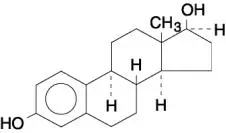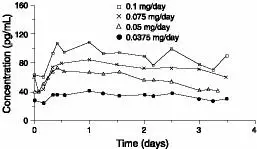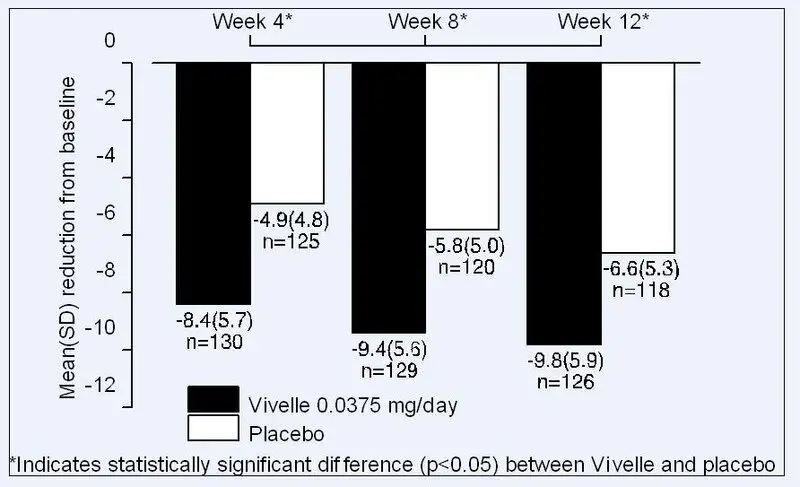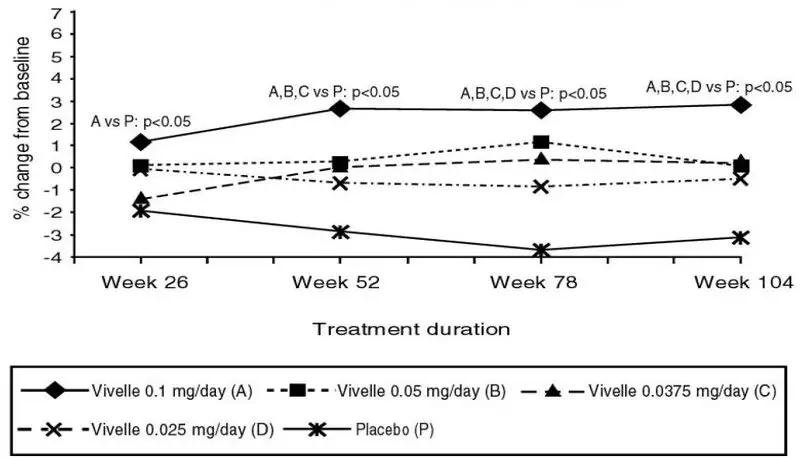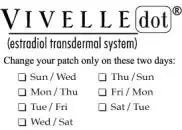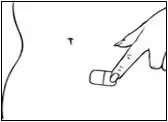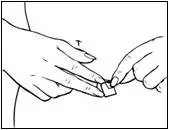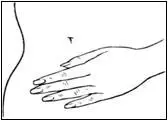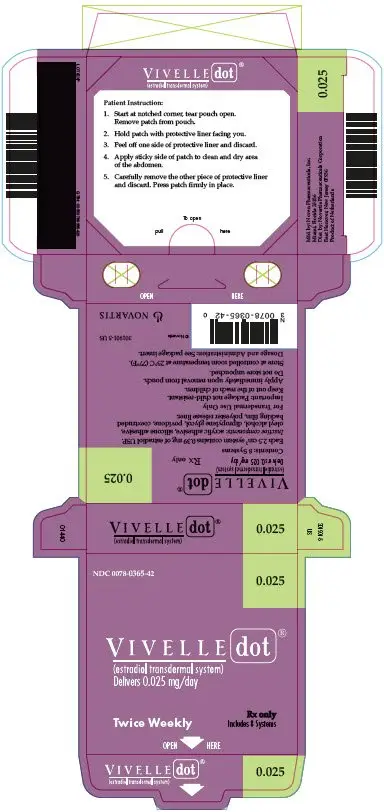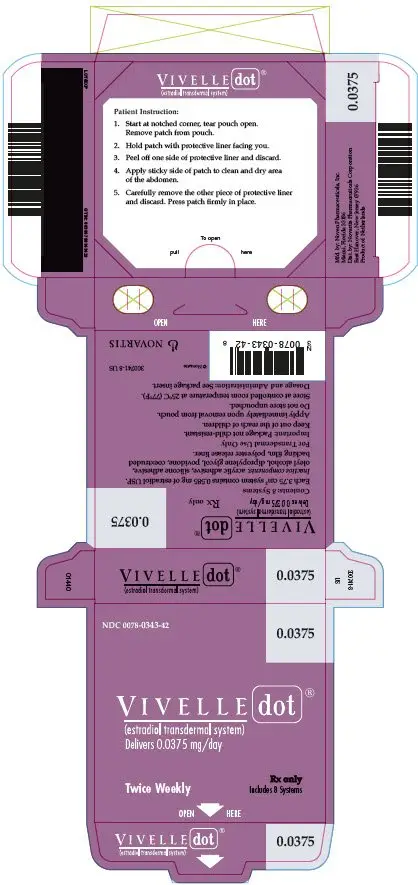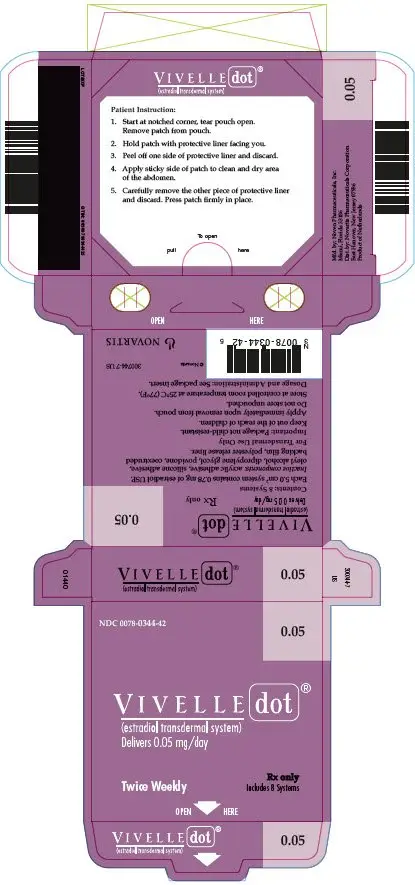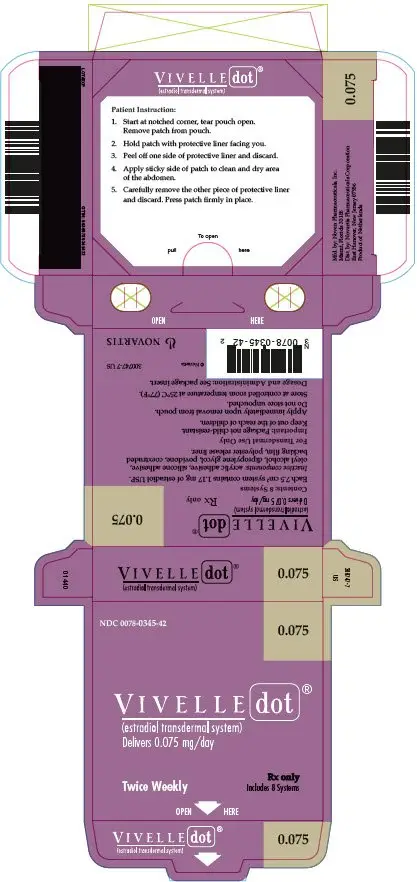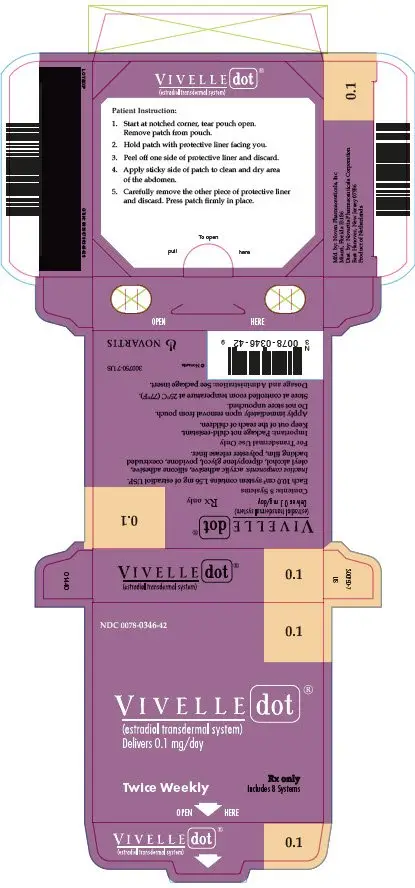Drug Detail:Vivelle-dot (skin patch) (Estradiol transdermal (skin patch) [ es-tra-dye-ole-tranz-derm-al ])
Drug Class: Estrogens
Highlights of Prescribing Information
VIVELLE-DOT® (estradiol transdermal system)
Initial U.S. Approval: 1996
WARNING: ENDOMETRIAL CANCER, CARDIOVASCULAR DISORDERS, PROBABLE DEMENTIA, and BREAST CANCER
See full prescribing information for complete boxed warning.
Estrogen-Alone Therapy
- There is an increased risk of endometrial cancer in a woman with a uterus who uses unopposed estrogens (5.2)
- The Women’s Health Initiative (WHI) estrogen-alone substudy reported increased risks of stroke and deep vein thrombosis (DVT) (5.1)
- The WHI Memory Study (WHIMS) estrogen-alone ancillary study of WHI reported an increased risk of developing probable dementia in postmenopausal women 65 years of age and older (5.3)
- Do not use estrogen-alone therapy for the prevention of cardiovascular disease or dementia (5.1, 5.3)
Estrogen Plus Progestin Therapy
- The WHI estrogen plus progestin substudy reported increased risks of DVT, pulmonary embolism (PE), stroke and myocardial infarction (MI) (5.1)
- The WHI estrogen plus progestin substudy reported increased risks of invasive breast cancer (5.2)
- The WHIMS estrogen plus progestin ancillary study of WHI reported an increased risk of developing probable dementia in postmenopausal women 65 years of age and older (5.3)
- Do not use estrogen plus progestogen therapy for the prevention of cardiovascular disease or dementia (5.1, 5.3)
Recent Major Changes
| Boxed Warning | 10/2021 |
Indications and Usage for Vivelle-Dot
Vivelle-Dot is an estrogen indicated for:
- Treatment of moderate to severe vasomotor symptoms due to menopause (1.1)
- Treatment of moderate to severe symptoms of vulvar and vaginal atrophy due to menopause (1.2)
Limitations of Use
When prescribing solely for the treatment of moderate to severe vaginal atrophy, first consider the use of topical vaginal products.
- Treatment of hypoestrogenism due to hypogonadism, castration, or primary ovarian failure (1.3)
- Prevention of postmenopausal osteoporosis (1.4)
Limitations of Use
When prescribing solely for the prevention of postmenopausal osteoporosis, first consider the use of non-estrogen medications. Consider estrogen therapy only for women at significant risk of osteoporosis.
Vivelle-Dot Dosage and Administration
- Start therapy with Vivelle-Dot 0.0375 mg/day applied to the skin twice weekly for the treatment of moderate to severe vasomotor symptoms due to menopause or moderate to severe symptoms of vulvar and vaginal atrophy symptoms due to menopause. Dosage adjustment should be guided by the clinical response (2.1, 2.2, 2.3)
- Start therapy with Vivelle-Dot 0.025 mg/day for the prevention of postmenopausal osteoporosis (2.4)
- Place Vivelle-Dot on a clean, dry area of the lower abdomen or buttocks. Do not apply Vivelle-Dot to the breasts (2.5)
Dosage Forms and Strengths
Transdermal system: 0.025 mg/day, 0.0375 mg/day, 0.05 mg/day, 0.075 mg/day, and 0.1 mg/day (3)
Contraindications
- Undiagnosed abnormal genital bleeding (4, 5.2)
- Breast cancer or a history of breast cancer (4, 5.2)
- Estrogen-dependent neoplasia (4, 5.2)
- Active DVT, PE or a history of these conditions (4, 5.1)
- Active arterial thromboembolic disease (for example, stroke and MI), or a history of these conditions (4, 5.1)
- Known anaphylactic reaction, or angioedema, or hypersensitivity with Vivelle-Dot (4, 5.15)
- Hepatic impairment or disease (4, 5.10)
- Protein C, protein S, or antithrombin deficiency, or other known thrombophilic disorders (4)
Warnings and Precautions
- Estrogens increase the risk of gallbladder disease (5.4)
- Discontinue estrogen if severe hypercalcemia, loss of vision, severe hypertriglyceridemia or cholestatic jaundice occurs (5.5, 5.6, 5.9, 5.10)
- Monitor thyroid function in women on thyroid replacement therapy (5.11, 5.18)
Adverse Reactions/Side Effects
The most common adverse reactions (≥ 10%) with Vivelle-Dot are: headache, breast tenderness, nasopharyngitis, sinusitis, sinus headache, upper respiratory tract infection, back pain, depression, and irregular vaginal bleeding or spotting. (6.1)
To report SUSPECTED ADVERSE REACTIONS, contact Novartis Pharmaceuticals Corporation at 1-888-669-6682 or FDA at 1-800-FDA-1088 or www.fda.gov/medwatch.
Drug Interactions
Inducers and/or inhibitors of CYP3A4 may affect estrogen drug metabolism and decrease or increase the estrogen plasma concentration. (7)
See 17 for PATIENT COUNSELING INFORMATION and FDA-approved patient labeling.
Revised: 10/2021
Related/similar drugs
estradiol, Premarin, Estrace, Prempro, Vagifem, Estrogel, ClimaraFull Prescribing Information
1. Indications and Usage for Vivelle-Dot
Vivelle-Dot is indicated for:
2. Vivelle-Dot Dosage and Administration
Generally, when estrogen is prescribed for a postmenopausal woman with a uterus, consider addition of a progestogen to reduce the risk of endometrial cancer. Generally, a woman without a uterus does not need to use a progestogen in addition to her estrogen therapy. In some cases, however, hysterectomized women who have a history of endometriosis may need a progestogen [see Warnings and Precautions (5.2, 5.14)].
Use estrogen-alone or in combination with a progestogen at the lowest effective dose and the shortest duration consistent with treatment goals and risks for the individual woman. Reevaluate postmenopausal women periodically as clinically appropriate to determine whether treatment is still necessary.
2.1 Treatment of Moderate to Severe Vasomotor Symptoms due to Menopause
Start therapy with Vivelle-Dot 0.0375 mg per day applied to the skin twice weekly. Make dosage adjustments based on the clinical response. Initiate Vivelle-Dot at once in a woman not currently taking oral estrogens or in a woman switching from another estradiol transdermal therapy. In women who are currently taking oral estrogens, initiate treatment with Vivelle-Dot 1 week after withdrawal of oral hormone therapy, or sooner if menopausal symptoms reappear in less than 1 week. Attempts to taper or discontinue Vivelle-Dot at 3 to 6-month intervals.
Give Vivelle-Dot continuously in a woman who does not have an intact uterus. In a woman with an intact uterus, give Vivelle-Dot on a cyclic schedule (for example, 3 weeks on Vivelle-Dot followed by 1 week off Vivelle-Dot).
2.2 Treatment of Moderate to Severe Symptoms of Vulvar and Vaginal Atrophy due to Menopause
Start therapy with Vivelle-Dot 0.0375 mg per day applied to the skin twice weekly. Dosage adjustment should be guided by the clinical response. Attempts to taper or discontinue Vivelle-Dot at 3 to 6-month intervals.
In women not currently taking oral estrogens or in women switching from another estradiol transdermal therapy, treatment with Vivelle-Dot may be initiated at once. In women who are currently taking oral estrogens, initiate treatment with Vivelle-Dot 1 week after withdrawal of oral hormone therapy, or sooner if menopausal symptoms reappear in less than 1 week.
Give Vivelle-Dot continuously in a woman who does not have an intact uterus. In a woman with an intact uterus, give Vivelle-Dot on a cyclic schedule (for example, 3 weeks on Vivelle-Dot followed by 1 week off Vivelle-Dot).
2.4 Prevention of Postmenopausal Osteoporosis
Start therapy with Vivelle-Dot 0.025 mg per day applied to the skin twice weekly.
In women not currently taking oral estrogens or in women switching from another estradiol transdermal therapy, treatment with Vivelle-Dot may be initiated at once. In women who are currently taking oral estrogens, initiate treatment with Vivelle-Dot 1 week after withdrawal of oral hormone therapy, or sooner if menopausal symptoms reappear in less than 1 week.
Vivelle-Dot may be given continuously in a woman who does not have an intact uterus. In a woman with an intact uterus, Vivelle-Dot may be given on a cyclic schedule (for example, 3 weeks on Vivelle-Dot followed by 1 week off Vivelle-Dot).
2.5 Application Instructions
Place the adhesive side of Vivelle-Dot on a clean, dry area of the trunk of the body (including the abdomen or buttocks). Do not apply Vivelle-Dot to the breasts.
Replace Vivelle-Dot twice weekly. Rotate the sites of application, with an interval of at least 1 week allowed between applications to a particular site. Select an area that is not oily, damaged, or irritated. Avoid the waistline, since tight clothing may rub the system off. Apply the system immediately after opening the pouch and removing the protective liner. Press the system firmly in place with the palm of the hand for about 10 seconds, making sure there is good contact, especially around the edges.
In the event that a system falls off, reapply the same system or apply a new system to another location. In either case, continue the original treatment schedule. If a woman has forgotten to apply Vivelle-Dot, have her apply a new system as soon as possible. Apply the new system on the original treatment schedule. The interruption of treatment in women taking Vivelle-Dot might increase the likelihood of breakthrough bleeding, spotting and recurrence of symptoms.
3. Dosage Forms and Strengths
Transdermal system: 0.025 mg/day, 0.0375 mg/day, 0.05 mg/day, 0.075 mg/day, and 0.1 mg/day.
4. Contraindications
Vivelle-Dot is contraindicated in women with any of the following conditions:
- Undiagnosed abnormal genital bleeding [see Warnings and Precautions (5.2)].
- Breast cancer or a history of breast cancer [see Warnings and Precautions (5.2)].
- Estrogen-dependent neoplasia [see Warnings and Precautions (5.2)].
- Active DVT, PE, or a history of these conditions [see Warnings and Precautions (5.1)].
- Active arterial thromboembolic disease (for example, stroke and MI), or a history of these conditions [see Warnings and Precautions (5.1)].
- Known anaphylactic reaction, or angioedema, or hypersensitivity to Vivelle-Dot
- Hepatic impairment or disease
- Protein C, protein S, or antithrombin deficiency, or other known thrombophilic disorders
5. Warnings and Precautions
5.1 Cardiovascular Disorders
Increased risks of stroke and DVT are reported with estrogen-alone therapy. Increased risks of PE, DVT, stroke, and MI are reported with estrogen plus progestin therapy. Immediately discontinue estrogen with or without progestogen therapy if any of these occur or are suspected.
Manage appropriately any risk factors for arterial vascular disease (for example, hypertension, diabetes mellitus, tobacco use, hypercholesterolemia, and obesity) and/or venous thromboembolism (VTE) (for example, personal history or family history of VTE, obesity, and systemic lupus erythematosus).
Stroke
The WHI estrogen-alone substudy reported a statistically significant increased risk of stroke in women 50 to 79 years of age receiving daily CE (0.625 mg)-alone compared to women in the same age group receiving placebo (45 versus 33 strokes per 10,000 women-years, respectively). The increase in risk was demonstrated in year 1 and persisted [see Clinical Studies (14.3)]. Immediately discontinue estrogen-alone therapy if a stroke occurs or is suspected.
Subgroup analyses of women 50 to 59 years of age suggest no increased risk of stroke for those women receiving CE (0.625 mg)-alone versus those receiving placebo (18 versus 21 per 10,000 women-years).1
The WHI estrogen plus progestin substudy reported a statistically significant increased risk of stroke in women 50 to 79 years of age receiving CE (0.625 mg) plus MPA (2.5 mg) compared to women in the same age group receiving placebo (33 versus 25 stokes per 10,000 women-years) [see Clinical Studies (14.3)]. The increase in risk was demonstrated after the first year and persisted.1 Immediately discontinue estrogen plus progestogen therapy if a stroke occurs or is suspected.
Coronary Heart Disease
The WHI estrogen-alone substudy reported no overall effect on coronary heart disease (CHD) events (defined as nonfatal MI, silent MI, or CHD death) in women receiving estrogen-alone compared to placebo2 [see Clinical Studies (14.3)].
Subgroup analyses of women 50 to 59 years of age, who were less than 10 years since menopause, suggest a reduction (not statistically significant) in CHD events in those women receiving daily CE (0.625 mg)–alone compared to placebo (8 versus 16 per 10,000 women-years).1
The WHI estrogen plus progestin substudy reported an increased risk (not statistically significant) in CHD events in women receiving daily CE (0.625 mg) plus MPA (2.5 mg) compared to women receiving placebo (41 versus 34 per 10,000 women-years).1 An increase in relative risk was demonstrated in year 1, and a trend toward decreasing relative risk was reported in years 2 through 5 [see Clinical Studies (14.3)].
In postmenopausal women with documented heart disease (n = 2,763, average 66.7 years of age), in a controlled clinical trial of secondary prevention of cardiovascular disease (Heart and Estrogen/Progestin Replacement Study; HERS), treatment with daily CE (0.625 mg) plus MPA (2.5 mg) demonstrated no cardiovascular benefit. During an average follow-up of 4.1 years, treatment with CE plus MPA did not reduce the overall rate of CHD events in postmenopausal women with established CHD. There were more CHD events in the CE plus MPA-treated group than in the placebo group in year 1, but not during the subsequent years. Two thousand three hundred twenty-one (2,321) women from the original HERS trial agreed to participate in an open-label extension of HERS, HERS II. Average follow-up in HERS II was an additional 2.7 years, for a total of 6.8 years overall. Rates of CHD events were comparable among women in the CE plus MPA group and the placebo group in the HERS, the HERS II, and overall.
Venous Thromboembolism
In the WHI estrogen-alone substudy, the risk of VTE (DVT and PE) was increased for women receiving daily CE (0.625 mg)-alone compared to placebo (30 versus 22 per 10,000 women-years), although only the increased risk of DVT reached statistical significance (23 versus 15 per 10,000 women-years). The increase in VTE risk was demonstrated during the first 2 years3 [see Clinical Studies (14.3)]. Immediately discontinue estrogen-alone therapy if a VTE occurs or is suspected.
The WHI estrogen plus progestin substudy reported a statistically significant 2-fold greater rate of VTE in women receiving daily CE (0.625 mg) plus MPA (2.5 mg) compared to women receiving placebo (35 versus 17 per 10,000 women-years). Statistically significant increases in risk for both DVT (26 versus 13 per 10,000 women-years) and PE (18 versus 8 per 10,000 women-years) were also demonstrated. The increase in VTE risk was demonstrated during the first year and persisted4 [see Clinical Studies (14.3)]. Immediately discontinue estrogen plus progestogen therapy if a VTE occurs or is suspected.
If feasible, discontinue estrogens at least 4 to 6 weeks before surgery of the type associated with an increased risk of thromboembolism, or during periods of prolonged immobilization.
5.2 Malignant Neoplasms
Endometrial Cancer
An increased risk of endometrial cancer has been reported with the use of unopposed estrogen therapy in a woman with a uterus. The reported endometrial cancer risk among unopposed estrogen users is about 2 to 12 times greater than in non-users and appears dependent on duration of treatment and on estrogen dose. Most studies show no significant increased risk associated with the use of estrogens for less than 1 year. The greatest risk appears to be associated with prolonged use, with increased risks of 15- to 24-fold for 5 to 10 years or more, and this risk has been shown to persist for at least 8 to 15 years after estrogen therapy is discontinued.
Clinical surveillance of all women using estrogen-alone or estrogen plus progestogen therapy is important. Perform adequate diagnostic measures, including directed or random endometrial sampling when indicated, to rule out malignancy in postmenopausal women with undiagnosed persistent or recurring abnormal genital bleeding with unknown etiology.
There is no evidence that the use of natural estrogens results in a different endometrial risk profile than synthetic estrogens of equivalent estrogen dose. Adding a progestogen to estrogen therapy has been shown to reduce the risk of endometrial hyperplasia, which may be a precursor to endometrial cancer.
Breast Cancer
The WHI substudy of daily CE (0.625 mg)-alone provided information about breast cancer in estrogen-alone users. In the WHI estrogen-alone substudy, after an average follow-up of 7.1 years, daily CE (0.625 mg)-alone was not associated with an increased risk of invasive breast cancer (relative risk [RR] 0.80)5 [see Clinical Studies (14.3)].
After a mean follow-up of 5.6 years, the WHI substudy of daily CE (0.625 mg) plus MPA (2.5 mg) reported an increased risk of invasive breast cancer in women who took daily CE plus MPA compared to placebo.
In this substudy, prior use of estrogen-alone or estrogen plus progestin therapy was reported by 26% of the women. The relative risk of invasive breast cancer was 1.24, and the absolute risk was 41 versus 33 cases per 10,000 women-years, for CE plus MPA compared with placebo. Among women who reported prior use of hormone therapy, the relative risk of invasive breast cancer was 1.86, and the absolute risk was 46 versus 25 cases per 10,000 women-years, for CE plus MPA compared with placebo.6 Among women who reported no prior use of hormone therapy, the relative risk of invasive breast cancer was 1.09, and the absolute risk was 40 versus 36 cases per 10,000 women-years for CE plus MPA compared with placebo. In the same substudy, invasive breast cancers were larger, were more likely to be node positive, and were diagnosed at a more advanced stage in the CE (0.625 mg) plus MPA (2.5 mg) group compared with the placebo group. Metastatic disease was rare, with no apparent difference between the two groups. Other prognostic factors, such as histologic subtype, grade, and hormone receptor status did not differ between the groups6 [see Clinical Studies (14.3)].
Consistent with the WHI clinical trial, observational studies have also reported an increased risk of breast cancer with estrogen plus progestin therapy, and a smaller increase in the risk for breast cancer with estrogen-alone therapy, after several years of use. The risk increased with duration of use and appeared to return to baseline over about 5 years after stopping treatment (only the observational studies have substantial data on risk after stopping). Observational studies also suggest that the risk of breast cancer was greater, and became apparent earlier, with estrogen plus progestin therapy as compared to estrogen-alone therapy. These studies have not generally found significant variation in the risk of breast cancer among different estrogen plus progestin combinations, doses, or routes of administration.
The use of estrogen-alone and estrogen plus progestin has been reported to result in an increase in abnormal mammograms requiring further evaluation. All women should receive yearly breast examinations by a healthcare provider and perform monthly breast self-examinations. In addition, mammography examinations should be scheduled based on patient age, risk factors, and prior mammogram results.
Ovarian Cancer
The CE plus MPA substudy of WHI reported that estrogen plus progestin increased the risk of ovarian cancer. After an average follow-up of 5.6 years, the relative risk for CE plus MPA versus placebo was 1.58 (95% CI, 0.77-3.24), but it was not statistically significant. The absolute risk for CE plus MPA versus placebo was 4 versus 3 cases per 10,000 women-years7.
A meta-analysis of 17 prospective and 35 retrospective epidemiology studies found that women who used hormonal therapy for menopausal symptoms had an increased risk for ovarian cancer. The primary analysis, using case-control comparisons, included 12,110 cancer cases from the 17 prospective studies. The relative risks associated with current use of hormonal therapy was 1.41 (95% confidence interval [CI] 1.32 to 1.50); there was no difference in the risk estimates by duration of the exposure (less than 5 years [median of 3 years] vs. greater than 5 years [median of 10 years] of use before the cancer diagnosis). The relative risk associated with combined current and recent use (discontinued use within 5 years before cancer diagnosis) was 1.37 (95% CI 1.27-1.48), and the elevated risk was significant for both estrogen-alone and estrogen plus progestin products. The exact duration of hormone therapy use associated with an increased risk of ovarian cancer, however, is unknown.
5.3 Probable Dementia
In the WHI Memory Study (WHIMS) estrogen-alone ancillary study, a population of 2,947 hysterectomized women 65 to 79 years of age was randomized to daily CE (0.625 mg)-alone or placebo.
After an average follow-up of 5.2 years, 28 women in the estrogen-alone group and 19 women in the placebo group were diagnosed with probable dementia. The relative risk of probable dementia for CE-alone versus placebo was 1.49 (95% CI, 0.83 to 2.66). The absolute risk of probable dementia for CE-alone versus placebo was 37 versus 25 cases per 10,000 women-years8 [see Use in Specific Populations (8.5), and Clinical Studies (14.4)].
In the WHIMS estrogen plus progestin ancillary study of WHI, a population of 4,532 postmenopausal women 65 to 79 years was randomized to daily CE (0.625 mg) plus MPA (2.5 mg) or placebo.
After an average follow-up of 4 years, 40 women in the CE plus MPA group and 21 women in the placebo group were diagnosed with probable dementia. The relative risk of probable dementia for CE plus MPA versus placebo was 2.05 (95% CI, 1.21 to 3.48). The absolute risk of probable dementia for CE plus MPA versus placebo was 45 versus 22 cases per 10,000 women-years8 [see Use in Specific Populations (8.5), and Clinical Studies (14.4)].
When data from the two populations in the WHIMS estrogen-alone and estrogen plus progestin ancillary studies were pooled as planned in the WHIMS protocol, the reported overall relative risk for probable dementia was 1.76 (95% CI, 1.19 to 2.60). Since both ancillary studies were conducted in women aged 65 to 79 years of age, it is unknown whether these findings apply to younger postmenopausal women8 [see Use in Specific Populations (8.5), and Clinical Studies (14.4)].
5.4 Gallbladder Disease
A 2- to 4-fold increase in the risk of gallbladder disease requiring surgery in postmenopausal women receiving estrogens has been reported.
5.5 Hypercalcemia
Estrogen administration may lead to severe hypercalcemia in women with breast cancer and bone metastases. Discontinue estrogens, including Vivelle-Dot, if hypercalcemia occurs, and take appropriate measures to reduce the serum calcium level.
5.6 Visual Abnormalities
Retinal vascular thrombosis has been reported in women receiving estrogens. Discontinue Vivelle-Dot pending examination if there is sudden partial or complete loss of vision, or a sudden onset of proptosis, diplopia, or migraine. Permanently discontinue estrogens, including Vivelle-Dot, if examination reveals papilledema or retinal vascular lesions.
5.7 Addition of a Progestogen When a Woman Has Not Had a Hysterectomy
Studies of the addition of a progestogen for 10 or more days of a cycle of estrogen administration, or daily with estrogen in a continuous regimen, have reported a lowered incidence of endometrial hyperplasia than would be induced by estrogen treatment alone. Endometrial hyperplasia may be a precursor to endometrial cancer.
There are, however, possible risks that may be associated with the use of progestogens with estrogens compared to estrogen-alone regimens. These include an increased risk of breast cancer.
5.8 Elevated Blood Pressure
In a small number of case reports, substantial increases in blood pressure have been attributed to idiosyncratic reactions to estrogens. In a large, randomized, placebo-controlled clinical trial, a generalized effect of estrogens on blood pressure was not seen.
5.9 Exacerbation of Hypertriglyceridemia
In women with preexisting hypertriglyceridemia, estrogen therapy may be associated with elevations of plasma triglycerides leading to pancreatitis. Discontinue Vivelle-Dot if pancreatitis occurs.
5.10 Hepatic Impairment and/or Past History of Cholestatic Jaundice
Estrogens may be poorly metabolized in women with hepatic impairment. Exercise caution in any woman with a history of cholestatic jaundice associated with past estrogen use or with pregnancy. In the case of recurrence of cholestatic jaundice, discontinue Vivelle-Dot.
5.11 Exacerbation of Hypothyroidism
Estrogen administration leads to increased thyroid-binding globulin (TBG) levels. Women with normal thyroid function can compensate for the increased TBG by making more thyroid hormone, thus maintaining free T4 and T3 serum concentrations in the normal range. Women dependent on thyroid hormone replacement therapy who are also receiving estrogens may require increased doses of their thyroid replacement therapy. Monitor thyroid function in these women during treatment with Vivelle-Dot to maintain their free thyroid hormone levels in an acceptable range.
5.12 Fluid Retention
Estrogens may cause some degree of fluid retention. Monitor any woman with a condition(s) that might predispose her to fluid retention, such as cardiac or renal impairment. Discontinue estrogen-alone therapy, including Vivelle-Dot, with evidence of medically concerning fluid retention.
5.13 Hypocalcemia
Estrogen-induced hypocalcemia may occur in women with hypoparathyroidism. Consider whether the benefits of estrogen therapy, including Vivelle-Dot, outweigh the risks in such women.
5.14 Exacerbation of Endometriosis
A few cases of malignant transformation of residual endometrial implants have been reported in women treated post-hysterectomy with estrogen-alone therapy. Consider the addition of progestogen therapy for women known to have residual endometriosis post-hysterectomy.
5.15 Severe Anaphylactic/Anaphylactoid Reactions and Angioedema
A few cases of anaphylactic/anaphylactoid reactions are reported in the postmarketing use of Vivelle-Dot. Involvement of skin (hives, pruritus, swollen lips-tongue-face) and either respiratory tract (respiratory compromise) or gastrointestinal tract (abdominal pain, vomiting) are noted.
Angioedema involving eye/eyelid, face, larynx, pharynx, tongue and extremity (hands, legs, ankles, and fingers) with or without urticaria requiring medical intervention are reported in the postmarketing use of Vivelle-Dot. Angioedema involving the tongue, glottis, or larynx, may result in airway obstruction. Do not give Vivelle-Dot to any woman who develops angioedema during treatment with Vivelle-Dot.
Exogenous estrogens may exacerbate symptoms of angioedema in women with hereditary angioedema. Consider whether the benefits of estrogen therapy outweigh the risks in such women.
5.16 Exacerbation of Other Conditions
Estrogen therapy, including Vivelle-Dot, may cause an exacerbation of asthma, diabetes mellitus, epilepsy, migraines, porphyria, systemic lupus erythematosus, and hepatic hemangiomas. Consider whether the benefits of estrogen therapy outweigh the risks in such women.
5.17 Laboratory Tests
Serum follicle-stimulating hormone (FSH) and estradiol levels have not been shown to be useful in the management of moderate to severe vasomotor symptoms and moderate to severe symptoms of vulvar and vaginal atrophy.
Laboratory parameters may be useful in guiding dosage for the treatment of hypoestrogenism due to hypogonadism, castration and primary ovarian failure.
5.18 Drug-Laboratory Test Interactions
- Accelerated prothrombin time, partial thromboplastin time, and platelet aggregation time; increased platelet count; increased factors II, VII antigen, VIII antigen, VIII coagulant activity, IX, X, XII, VII-X complex, II-VII-X complex; and beta-thromboglobulin; decreased levels of anti-factor Xa and antithrombin III; decreased antithrombin III activity; increased levels of fibrinogen and fibrinogen activity; increased plasminogen antigen and activity.
- Increased thyroid-binding globulin (TBG) leading to increased circulating total thyroid hormone levels, as measured by protein-bound iodine (PBI), T4 levels (by column or by radioimmunoassay) or T3 levels by radioimmunoassay. T3 resin uptake is decreased, reflecting the elevated TBG. Free T4 and free T3 concentrations are unaltered. Women on thyroid replacement therapy may require higher doses of thyroid hormone.
- Other binding proteins may be elevated in serum, for example, corticosteroid-binding globulin (CBG), sex hormone-binding globulin (SHBG), leading to increased total circulating corticosteroids and sex steroids, respectively. Free hormone concentrations, such as testosterone and estradiol, may be decreased. Other plasma proteins may be increased (angiotensinogen/renin substrate, alpha-1-antitrypsin, ceruloplasmin).
- Increased plasma high-density lipoprotein (HDL) and HDL2 cholesterol subfraction concentrations, reduced low-density lipoprotein (LDL) cholesterol concentration, and increased triglycerides levels.
- Impaired glucose tolerance.
6. Adverse Reactions/Side Effects
The following serious adverse reactions are discussed elsewhere in labeling:
- Cardiovascular Disorders [see Boxed Warning, Warnings and Precautions (5.1)]
- Malignant Neoplasms [see Boxed Warning, Warnings and Precautions (5.2)]
6.1 Clinical Trials Experience
Because clinical trials are conducted under widely varying conditions, adverse reaction rates observed in the clinical trials of a drug cannot be directly compared to rates in the clinical trials of another drug and may not reflect the rates observed in practice.
There were no clinical trials conducted with Vivelle-Dot. Vivelle-Dot is bioequivalent to Vivelle®. The following adverse reactions have been reported with Vivelle therapy:
| †Represents milligrams of estradiol delivered daily by each system. | ||||||
| *NOS represents not otherwise specified. | ||||||
| **NEC represents not elsewhere classified. | ||||||
| ***Application site erythema and application site irritation were observed in a small number of patients (3.2% or less of patients across treatment groups). | ||||||
| Vivelle 0.025 mg/day† (N = 47) N (%) | Vivelle 0.0375 mg/day† (N = 130) N (%) | Vivelle 0.05 mg/day† (N = 103) N (%) | Vivelle 0.075 mg/day† (N = 46) N (%) | Vivelle 0.1 mg/day† (N = 132) N (%) | Placebo (N = 157) N (%) |
|
| Gastrointestinal disorders | ||||||
| Constipation | 2 (4.3) | 5 (3.8) | 4 (3.9) | 3 (6.5) | 2 (1.5) | 4 (2.5) |
| Dyspepsia | 4 (8.5) | 12 (9.2) | 3 (2.9) | 2 (4.3) | 0 | 10 (6.4) |
| Nausea | 2 (4.3) | 8 (6.2) | 4 (3.9) | 0 | 7 (5.3) | 5 (3.2) |
| General disorders and administration site conditions*** | ||||||
| Influenza-like illness | 3 (6.4) | 6 (4.6) | 8 (7.8) | 0 | 3 (2.3) | 10 (6.4) |
| Pain NOS* | 0 | 8 (6.2) | 0 | 2 (4.3) | 7 (5.3) | 7 (4.5) |
| Infections and infestations | ||||||
| Influenza | 4 (8.5) | 4 (3.1) | 6 (5.8) | 0 | 10 (7.6) | 14 (8.9) |
| Nasopharyngitis | 3 (6.4) | 16 (12.3) | 10 (9.7) | 9 (19.6) | 11 (8.3) | 24 (15.3) |
| Sinusitis NOS* | 4 (8.5) | 17 (13.1) | 13 (12.6) | 3 (6.5) | 7 (5.3) | 16 (10.2) |
| Upper respiratory tract infection NOS* | 3 (6.4) | 8 (6.2) | 11 (10.7) | 4 (8.7) | 6 (4.5) | 9 (5.7) |
| Investigations | ||||||
| Weight increased | 4 (8.5) | 5 (3.8) | 2 (1.9) | 2 (4.3) | 0 | 3 (1.9) |
| Musculoskeletal and connective tissue disorders | ||||||
| Arthralgia | 0 | 11 (8.5) | 4 (3.9) | 2 (4.3) | 5 (3.8) | 9 (5.7) |
| Back pain | 4 (8.5) | 10 (7.7) | 9 (8.7) | 4 (8.7) | 14 (10.6) | 10 (6.4) |
| Neck pain | 3 (6.4) | 4 (3.1) | 4 (3.9) | 0 | 6 (4.5) | 2 (1.3) |
| Pain in limb | 0 | 10 (7.7) | 7 (6.8) | 2 (4.3) | 6 (4.5) | 9 (5.7) |
| Nervous system disorders | ||||||
| Headache NOS* | 7 (14.9) | 35 (26.9) | 32 (31.1) | 23 (50.0) | 34 (25.8) | 37 (23.6) |
| Sinus headache | 0 | 12 (9.2) | 5 (4.9) | 5 (10.9) | 2 (1.5) | 8 (5.1) |
| Psychiatric disorders | ||||||
| Anxiety NEC** | 3 (6.4) | 5 (3.8) | 0 | 0 | 2 (1.5) | 4 (2.5) |
| Depression | 5 (10.6) | 4 (3.1) | 7 (6.8) | 0 | 4 (3.0) | 6 (3.8) |
| Insomnia | 3 (6.4) | 6 (4.6) | 4 (3.9) | 2 (4.3) | 2 (1.5) | 9 (5.7) |
| Reproductive system and breast disorders | ||||||
| Breast tenderness | 8 (17.0) | 10 (7.7) | 8 (7.8) | 3 (6.5) | 17 (12.9) | 0 |
| Dysmenorrhea | 0 | 0 | 0 | 3 (6.5) | 0 | 0 |
| Intermenstrual bleeding | 3 (6.4) | 9 (6.9) | 6 (5.8) | 0 | 14 (10.6) | 7 (4.5) |
| Respiratory, thoracic and mediastinal disorders | ||||||
| Sinus congestion | 0 | 4 (3.1) | 3 (2.9) | 3 (6.5) | 6 (4.5) | 7 (4.5) |
| Vascular disorders | ||||||
| Hot flushes NOS* | 3 (6.4) | 0 | 3 (2.9) | 0 | 0 | 6 (3.8) |
| Hypertension NOS* | 2 (4.3) | 0 | 3 (2.9) | 0 | 0 | 2 (1.3) |
6.2 Postmarketing Experience
The following additional adverse reactions have been identified during post-approval use of Vivelle-Dot. Because these reactions are reported voluntarily from a population of uncertain size, it is not always possible to reliably estimate their frequency or establish a causal relationship to drug exposure.
Genitourinary System
Vaginal hemorrhage and abnormal withdrawal bleeding or flow, breakthrough bleeding, spotting, uterine leiomyomata, vaginitis, vaginal discharge, ovarian cancer, endometrial hyperplasia, dysmenorrhea.
Breast
Enlargement, pain, nipple discharge, fibrocystic breast changes, breast cancer.
Cardiovascular
Deep venous thrombosis, pulmonary embolism, thrombophlebitis.
Gastrointestinal
Nausea, vomiting, abdominal cramps, bloating, cholelithiasis, liver function tests abnormal, diarrhea.
Skin
Application site reactions include localized bleeding, bruising, burning, discomfort, dryness, eczema, edema, erythema, erythema multiforme, erythema nodosum, inflammation, irritation, pain, papules and vesicles. Other skin reactions include paresthesia, skin discoloration, skin pigmentation, urticaria, swelling, loss of scalp hair, hirsutism, pruritus, and rash.
Eyes
Intolerance to contact lenses.
Central Nervous System
Migraine, dizziness, chorea, nervousness, affect liability, irritability.
Miscellaneous
Decrease in weight, reduced carbohydrate tolerance, edema, arthralgias, leg cramps, changes in libido, purpura, hypersensitivity, anaphylactic reaction, anaphylactoid reaction, angioedema.
7. Drug Interactions
In vitro and in vivo studies have shown that estrogens are metabolized partially by cytochrome P450 3A4 (CYP3A4). Therefore, inducers or inhibitors of CYP3A4 may affect estrogen drug metabolism. Inducers of CYP3A4 such as St. John’s wort (Hypericum perforatum) preparations, phenobarbital, carbamazepine and rifampin may reduce plasma concentrations of estrogens, possibly resulting in a decrease in therapeutic effects and/or changes in the uterine bleeding profile. Inhibitors of CYP3A4 such as erythromycin, clarithromycin, ketoconazole, itraconazole, ritonavir, and grapefruit juice may increase plasma concentrations of estrogens and may result in adverse reactions.
8. Use In Specific Populations
8.1 Pregnancy
Risk Summary
Vivelle-Dot is not indicated for use in pregnancy. There are no data with the use of Vivelle-Dot in pregnant women; however, epidemiologic studies and meta-analyses have not found an increased risk of genital or nongenital birth defects (including cardiac anomalies and limb-reduction defects) following exposure to combined hormonal contraceptives (estrogen and progestins) before conception or during early pregnancy.
In the U.S. general population, the estimated background risk of major birth defects and miscarriage in clinically recognized pregnancies is 2% to 4% and 15% to 20%, respectively.
8.2 Lactation
Risk Summary
Estrogens are present in human milk and can reduce milk production in breast-feeding women. This reduction can occur at any time but is less likely to occur once breast-feeding is well-established.
The developmental and health benefits of breastfeeding should be considered along with the mother’s clinical need for Vivelle-Dot and any potential adverse effects on the breastfed child from Vivelle-Dot or from the underlying maternal condition.
8.4 Pediatric Use
Vivelle-Dot is not indicated for use in pediatric patients. Clinical studies have not been conducted in the pediatric population.
If estrogen is administered to patients whose bone growth is not complete, periodic monitoring of bone maturation and effects on epiphyseal centers is recommended during estrogen administration.
8.5 Geriatric Use
There have not been sufficient numbers of geriatric women involved in clinical studies utilizing Vivelle-Dot to determine whether those over 65 years of age differ from younger subjects in their response to Vivelle-Dot.
The Women’s Health Initiative Studies
In the WHI estrogen-alone substudy (daily CE [0.625 mg]-alone versus placebo), there was a higher relative risk of stroke in women greater than 65 years of age [see Warnings and Precautions (5.1), and Clinical Studies (14.3)].
In the WHI estrogen plus progestin substudy (daily CE [0.625 mg] plus MPA [2.5 mg] versus placebo), there was a higher relative risk of nonfatal stroke and invasive breast cancer in women greater than 65 years of age [see Warnings and Precautions (5.1), and Clinical Studies (14.3)].
The Women’s Health Initiative Memory Study
In the WHIMS ancillary studies of postmenopausal women 65 to 79 years of age, there was an increased risk of developing probable dementia in women receiving estrogen-alone or estrogen plus progestin when compared to placebo [see Warnings and Precautions (5.3), and Clinical Studies (14.4)].
Since both ancillary studies were conducted in women 65 to 79 years of age, it is unknown whether these findings apply to younger postmenopausal women8 [see Warnings and Precautions (5.3), and Clinical Studies (14.4)].
| VIVELLE-DOT
estradiol patch, extended release |
|||||||||||||||||||||||||||||||||||||||||||||
|
|||||||||||||||||||||||||||||||||||||||||||||
|
|||||||||||||||||||||||||||||||||||||||||||||
|
|||||||||||||||||||||||||||||||||||||||||||||
|
|||||||||||||||||||||||||||||||||||||||||||||
|
|||||||||||||||||||||||||||||||||||||||||||||
| VIVELLE-DOT
estradiol patch, extended release |
|||||||||||||||||||||||||||||||||||||||||||||
|
|||||||||||||||||||||||||||||||||||||||||||||
|
|||||||||||||||||||||||||||||||||||||||||||||
|
|||||||||||||||||||||||||||||||||||||||||||||
|
|||||||||||||||||||||||||||||||||||||||||||||
|
|||||||||||||||||||||||||||||||||||||||||||||
| VIVELLE-DOT
estradiol patch, extended release |
|||||||||||||||||||||||||||||||||||||||||||||
|
|||||||||||||||||||||||||||||||||||||||||||||
|
|||||||||||||||||||||||||||||||||||||||||||||
|
|||||||||||||||||||||||||||||||||||||||||||||
|
|||||||||||||||||||||||||||||||||||||||||||||
|
|||||||||||||||||||||||||||||||||||||||||||||
| VIVELLE-DOT
estradiol patch, extended release |
|||||||||||||||||||||||||||||||||||||||||||||
|
|||||||||||||||||||||||||||||||||||||||||||||
|
|||||||||||||||||||||||||||||||||||||||||||||
|
|||||||||||||||||||||||||||||||||||||||||||||
|
|||||||||||||||||||||||||||||||||||||||||||||
|
|||||||||||||||||||||||||||||||||||||||||||||
| VIVELLE-DOT
estradiol patch, extended release |
|||||||||||||||||||||||||||||||||||||||||||||
|
|||||||||||||||||||||||||||||||||||||||||||||
|
|||||||||||||||||||||||||||||||||||||||||||||
|
|||||||||||||||||||||||||||||||||||||||||||||
|
|||||||||||||||||||||||||||||||||||||||||||||
|
|||||||||||||||||||||||||||||||||||||||||||||
| Labeler - Novartis Pharmaceuticals Corporation (002147023) |




